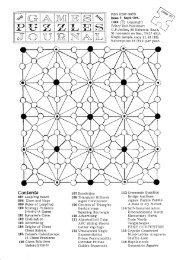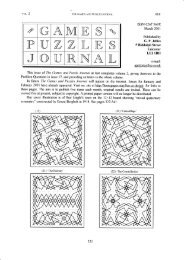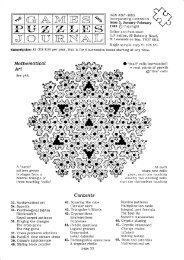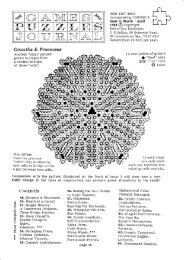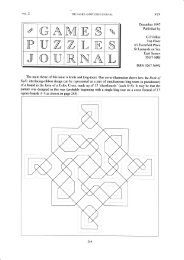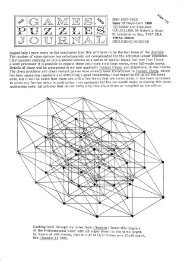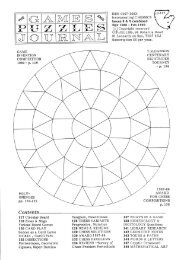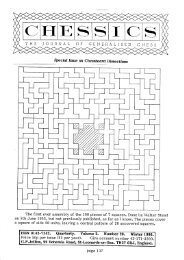The Games and Puzzles Journal, #5+6 - Mayhematics
The Games and Puzzles Journal, #5+6 - Mayhematics
The Games and Puzzles Journal, #5+6 - Mayhematics
Create successful ePaper yourself
Turn your PDF publications into a flip-book with our unique Google optimized e-Paper software.
c5<br />
.41>"<br />
Q\" Pertnutable Prtmes<br />
THE GAhIES AND PV7"Z'LES JOURNAL<br />
A permutable prime is one that remains prime if its digits are permuted in any<br />
other order. <strong>The</strong> single-digit primes 2,3,5,7 are trivially permutable. <strong>The</strong> digits 012,4,<br />
5, 6, 8 cannot occur in any permutable prime of two or more digits since they can be<br />
permuted to the units place to produce a number divisible by 2 or 5. All higher permutable<br />
primes are therefore formed from the digits L,3r7,9.<br />
<strong>The</strong> two-digit permutable primes are: 11;13,31;17,7!i37 r73;79,97, <strong>and</strong> the threedigit<br />
cases are: 1 1 3,1 31,3 1 1 ;337,3?3,733;1 99191 9,991.<br />
<strong>The</strong>re are, perhaps surprisingly, no four-digit permutable primes, since:<br />
(a) 1379 = 7 x tg7 r eliminating the form abcd,<br />
(b) abab = 101 x ab, eliminating the forms abab <strong>and</strong> aaaa,<br />
(c) 1711 = 29 x59, 1333 = 31 x 43, 3337 = 47 x 7L, 7771= 19 x 409, 9919 = 7 x1417, <strong>and</strong><br />
9997 = 13 x 769, eliminating form aaab (other cases are divisible by 3),<br />
(d) 1139 = 1? x 6?, 1gg9 = 18 x 109, 183? ='I x191, 93?B = 7 x1939, 7978 = ? x 1139,<br />
1939 = 7 x 277, 1?99 = 7 x 257, 7399 = 7 x 1057, eliminating the form aabc.<br />
Whether there is a largest permutable prime is unknown. <strong>The</strong> o^nly others known are<br />
those consisting of repeat"d" oner (rep-unit primes), i.e. numbers of the form (10I'-1)/9'<br />
<strong>The</strong> latest information i have is that primes occur when A= 21 19' 23' 317' 1031'<br />
In the binary system, the permutable primes are: 10 (2)' 11 (3)' 111 (7), 11111 (31)<br />
<strong>and</strong> so on, that is (above 2) primes of the form 2n-1. <strong>The</strong>se are known as Mersenners numbers,<br />
<strong>and</strong> 29 cases are now known: n=2,3r5r7rL3r1.7r19,31,61,81r107rt2715211607rL27912203, 2281,<br />
3277, 4253, 4429,9699, 9941, 11213, 1993?, 21701,23209,44497,86243,132049 (as listed<br />
in W.W.Rouse Ball & H.S.M.Coxeter Mathematical Recreations & Essays, 13th edn, p 65).<br />
Intheternarysystem,tnepe(5),21(?),111(13),<br />
no more of three or four digits.<br />
Readers may like to investigate other cases.<br />
Circular Primes<br />
G.J.SUGGETT proposes the problem of finding primes that remain prime when their<br />
digits are permuted'circularly (i.e. digits are taken from one end <strong>and</strong> put at the other).<br />
ge.-sides the permutable primel there iJ an extra case of 3 digits.<strong>and</strong> two extra cases each<br />
of 4, 5 anO e Oigits (couniing a number <strong>and</strong> its permutes as one case).<br />
Iniirculnble Sets<br />
While we are on the subject of circular permutations, it may be of interest to note<br />
that a set that cannot be circularly permuted must have more than a4 infinity of members!<br />
A permutation is a one-to-one correspondence of a set with itself. A finit9 set is<br />
one thaiGi6TE placed in one-to-one correspondence with a proper subset of itself.<br />
Any other, set is infinite. [Alt ordinary everyday sets are finite - infinite sets only exist<br />
in the fevered imaginations of mathematicians!l<br />
A circular permutation of a set X may be defined as a permutation of X that leaves<br />
noDroDersubsetffi"ii.lt**"consideran'eIementethentheelementse,Pe,P2e,<br />
p3e, ..., Pre, ... must all be different until, in the finite ease' we reach the number n of<br />
elements in X, when Petr=e. In the case of an infinite set a tcircularr permutation orders<br />
the set into an endless succession: ...(-P)rer...,(-P)e,e,Pe,...rPre,...(where -P is the opposite<br />
permutation: -Pa=b if <strong>and</strong> only if a=Pb). <strong>The</strong> 'number' of elements in an infinite circularly<br />
permutable set is thus the first infinity (denoted oo). Sets of higher infinity (like all the<br />
trealf numbers) cannot be circularly permuted.<br />
Show that the rational numbers gan be circularly Permuted.<br />
It may be as well to note here that a cyclic permutation differs from a circular permutation<br />
in that it circularly permutes some eiffie-nts but leaves the rest, if any, invariant.<br />
We can now return fult circle to the topic at the top of the preceding page <strong>and</strong> note<br />
that a derangement is a permutation that leaves no single element invariant. A circular<br />
permuta-ion is always a derangement, except when n=1. In fact a derangement is a union<br />
of circular permutations of mutually exclusive sets of two or more elements.<br />
Page 90




